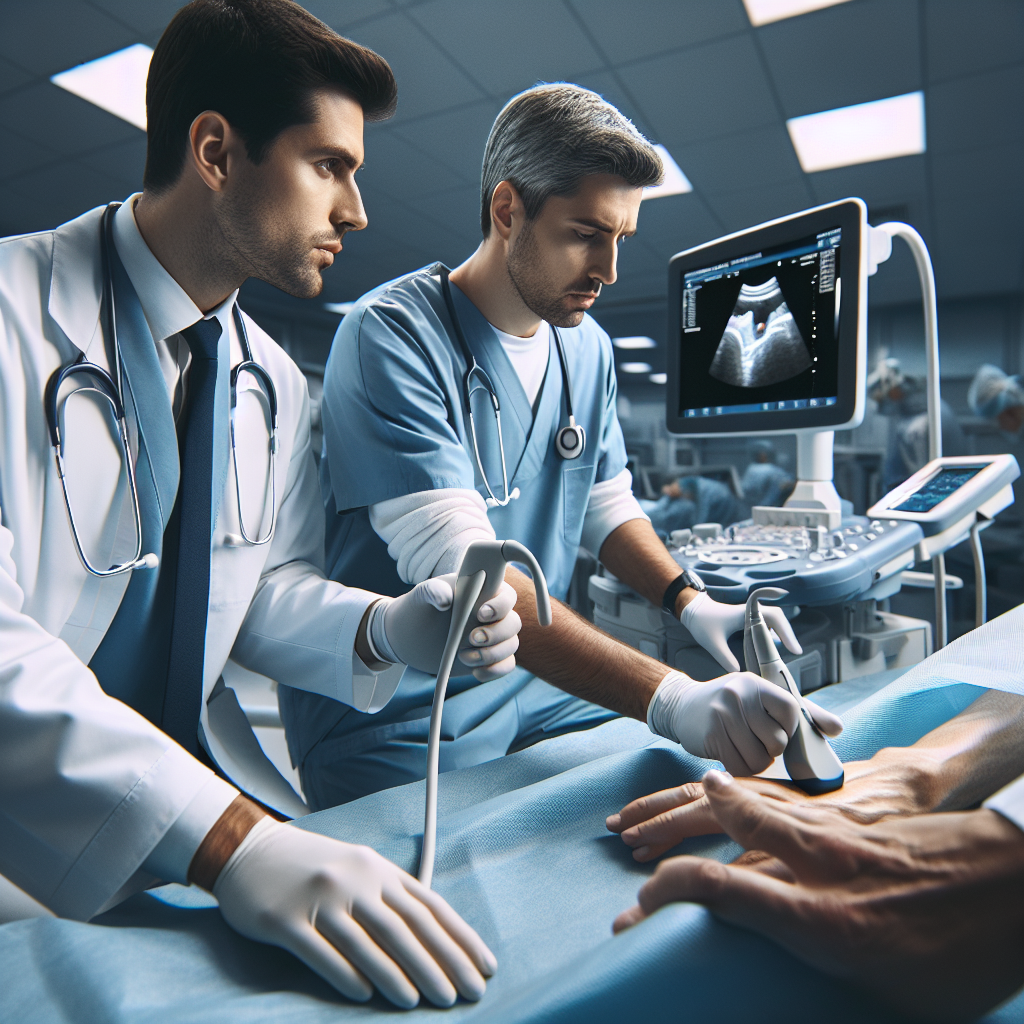Ultrasound-Guided Regional Anesthesia: The Ultimate Training Course5 min read

Are you a medical professional looking to master ultrasound-guided regional anesthesia techniques? This comprehensive training course provides the essential knowledge and skills needed to effectively incorporate ultrasound into your anesthesia practice. Discover how to optimize patient outcomes, improve procedural efficiency, and enhance your clinical expertise with this in-depth guide.
Fundamentals of Ultrasound Equipment Setup
To begin, it’s crucial to understand the basics of ultrasound equipment setup. Proper configuration ensures optimal imaging quality and accurate nerve localization. Key components include:
Transducer Selection
Choose the appropriate transducer based on the targeted nerve and anatomical region. High-frequency linear transducers (8-18 MHz) are ideal for superficial structures, while lower-frequency curved transducers (2-5 MHz) are better suited for deeper targets.
Machine Settings Optimization
Adjust the machine settings to enhance image clarity and resolution. Optimize the gain, depth, and focus to improve nerve visualization. Utilize tissue harmonic imaging and compound imaging modes when available to reduce artifacts and improve contrast.
Needle Visualization Techniques
Employ strategies to enhance needle visualization during procedures. Use in-plane or out-of-plane approaches depending on the nerve location and operator preference. Adjust the needle insertion angle to maximize visibility and maintain a safe distance from critical structures.
Mastering Nerve Block Techniques
With a solid foundation in equipment setup, the next step is to master specific nerve block techniques. This course covers a wide range of regional anesthesia procedures, including:
Upper Extremity Blocks
Learn to perform interscalene, supraclavicular, infraclavicular, and axillary brachial plexus blocks. Understand the indications, contraindications, and potential complications associated with each approach. Practice needle placement and local anesthetic distribution using ultrasound guidance.
Lower Extremity Blocks
Gain expertise in femoral, sciatic, popliteal, and ankle blocks. Master the techniques for localizing the targeted nerves and safely depositing local anesthetics. Recognize the anatomical variations and adjust your approach accordingly to ensure successful blockade.
Truncal Blocks
Explore the applications of transversus abdominis plane (TAP), rectus sheath, and paravertebral blocks. Learn how these techniques can provide effective analgesia for abdominal and thoracic surgeries. Understand the anatomical landmarks and ultrasound-guided approaches for precise needle placement.
Anatomical Landmarks and Sonoanatomy
A thorough understanding of anatomical landmarks and sonoanatomy is essential for successful ultrasound-guided regional anesthesia. This course provides detailed instruction on:
Surface Anatomy Identification
Learn to identify key surface landmarks that guide needle insertion points and trajectories. Recognize the relationships between bony prominences, muscle groups, and neurovascular structures. Practice palpation techniques to locate optimal injection sites.
Sonoanatomical Interpretation
Develop the skills to interpret ultrasound images accurately. Identify nerves, vessels, and surrounding tissues in various anatomical planes. Recognize common anatomical variations and adjust your technique accordingly. Correlate sonoanatomical findings with surface landmarks to ensure precise needle placement.
Real-Time Needle Guidance
Master the art of real-time needle guidance using ultrasound. Learn to track the needle tip throughout the procedure, ensuring accurate local anesthetic deposition. Practice needle repositioning techniques to optimize spread and avoid complications.
Safety Considerations and Complication Management
Patient safety is paramount in regional anesthesia. This course emphasizes the importance of:
Pre-Procedure Assessment
Conduct a thorough pre-procedure assessment to identify potential contraindications and risk factors. Review the patient’s medical history, allergies, and coagulation status. Obtain informed consent and discuss the risks and benefits of the planned procedure.
Aseptic Technique
Adhere to strict aseptic techniques to minimize the risk of infection. Properly prepare the skin, use sterile ultrasound gel, and maintain a clean workspace. Follow institutional guidelines for hand hygiene and personal protective equipment.
Complication Recognition and Management
Be prepared to recognize and manage potential complications associated with regional anesthesia. Monitor for signs of local anesthetic toxicity, nerve injury, or hematoma formation. Have emergency protocols in place and be ready to initiate appropriate interventions if necessary.
Integrating Ultrasound into Clinical Practice
Successful integration of ultrasound into your clinical practice requires ongoing skill development and quality improvement. This course provides guidance on:
Simulation Training
Engage in simulation-based training to refine your ultrasound-guided regional anesthesia techniques. Practice on phantoms or cadavers to gain hands-on experience in a controlled environment. Participate in workshops and seminars to learn from experienced practitioners.
Collaborative Learning
Foster a collaborative learning environment within your institution. Share knowledge and experiences with colleagues to enhance collective expertise. Participate in case discussions and peer review sessions to identify areas for improvement and share best practices.
Continuous Quality Improvement
Implement a continuous quality improvement program to monitor the outcomes of your ultrasound-guided regional anesthesia practice. Track success rates, complications, and patient satisfaction. Use this data to identify opportunities for further training and process optimization.
What are the key components of ultrasound equipment setup for regional anesthesia?
The key components of ultrasound equipment setup include selecting the appropriate transducer based on the targeted nerve and anatomical region, optimizing machine settings to enhance image clarity and resolution, and employing needle visualization techniques to ensure accurate and safe needle placement.
What are some common nerve block techniques covered in this course?
This course covers a wide range of nerve block techniques, including upper extremity blocks (interscalene, supraclavicular, infraclavicular, and axillary), lower extremity blocks (femoral, sciatic, popliteal, and ankle), and truncal blocks (transversus abdominis plane, rectus sheath, and paravertebral).
How can I enhance my understanding of anatomical landmarks and sonoanatomy?
To enhance your understanding of anatomical landmarks and sonoanatomy, focus on identifying key surface landmarks, interpreting ultrasound images accurately, and mastering the art of real-time needle guidance. Practice correlating sonoanatomical findings with surface landmarks to ensure precise needle placement.
What safety considerations should I keep in mind when performing ultrasound-guided regional anesthesia?
Safety considerations include conducting a thorough pre-procedure assessment, adhering to strict aseptic techniques, and being prepared to recognize and manage potential complications. Always prioritize patient safety and have emergency protocols in place.
How can I effectively integrate ultrasound into my clinical practice?
Effective integration of ultrasound into your clinical practice involves engaging in simulation training, fostering a collaborative learning environment, and implementing a continuous quality improvement program. Continuously refine your skills, share knowledge with colleagues, and monitor outcomes to optimize your practice.
In conclusion, this comprehensive training course equips you with the knowledge and skills necessary to excel in ultrasound-guided regional anesthesia. By mastering the fundamentals of equipment setup, nerve block techniques, anatomical landmarks, and safety considerations, you can enhance your clinical expertise and provide exceptional patient care. Embrace the power of ultrasound technology and elevate your anesthesia practice to new heights.
